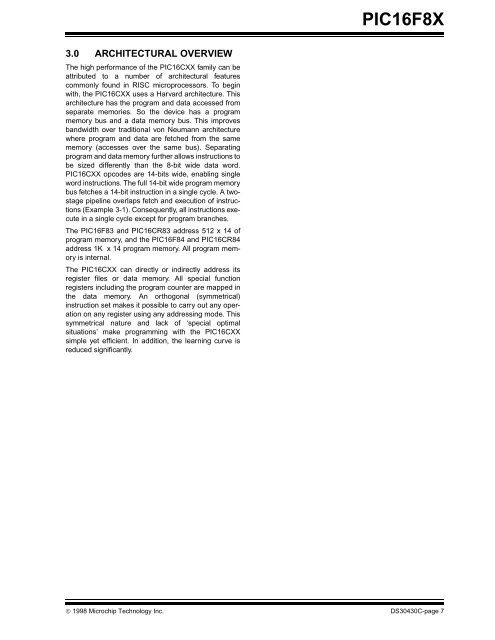PIC16F8X, 18-Pin FLASH/EEPROM 8-Bit MCU Data Sheet - Microchip
PIC16F8X, 18-Pin FLASH/EEPROM 8-Bit MCU Data Sheet - Microchip
PIC16F8X, 18-Pin FLASH/EEPROM 8-Bit MCU Data Sheet - Microchip
You also want an ePaper? Increase the reach of your titles
YUMPU automatically turns print PDFs into web optimized ePapers that Google loves.
3.0 ARCHITECTURAL OVERVIEW<br />
The high performance of the PIC16CXX family can be<br />
attributed to a number of architectural features<br />
commonly found in RISC microprocessors. To begin<br />
with, the PIC16CXX uses a Harvard architecture. This<br />
architecture has the program and data accessed from<br />
separate memories. So the device has a program<br />
memory bus and a data memory bus. This improves<br />
bandwidth over traditional von Neumann architecture<br />
where program and data are fetched from the same<br />
memory (accesses over the same bus). Separating<br />
program and data memory further allows instructions to<br />
be sized differently than the 8-bit wide data word.<br />
PIC16CXX opcodes are 14-bits wide, enabling single<br />
word instructions. The full 14-bit wide program memory<br />
bus fetches a 14-bit instruction in a single cycle. A twostage<br />
pipeline overlaps fetch and execution of instructions<br />
(Example 3-1). Consequently, all instructions execute<br />
in a single cycle except for program branches.<br />
The PIC16F83 and PIC16CR83 address 512 x 14 of<br />
program memory, and the PIC16F84 and PIC16CR84<br />
address 1K x 14 program memory. All program memory<br />
is internal.<br />
The PIC16CXX can directly or indirectly address its<br />
register files or data memory. All special function<br />
registers including the program counter are mapped in<br />
the data memory. An orthogonal (symmetrical)<br />
instruction set makes it possible to carry out any operation<br />
on any register using any addressing mode. This<br />
symmetrical nature and lack of ‘special optimal<br />
situations’ make programming with the PIC16CXX<br />
simple yet efficient. In addition, the learning curve is<br />
reduced significantly.<br />
<strong>PIC16F8X</strong><br />
© 1998 <strong>Microchip</strong> Technology Inc. DS30430C-page 7

















